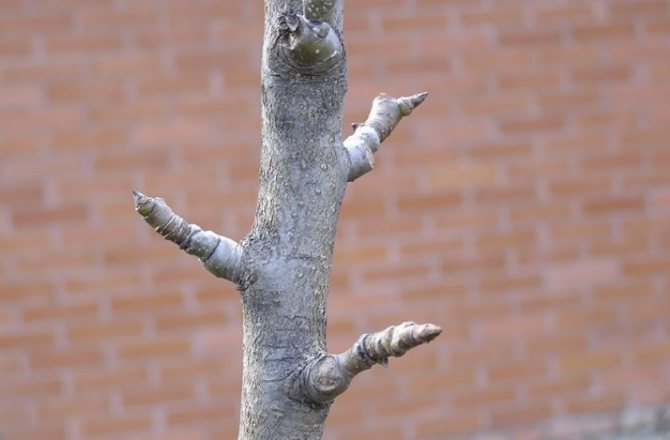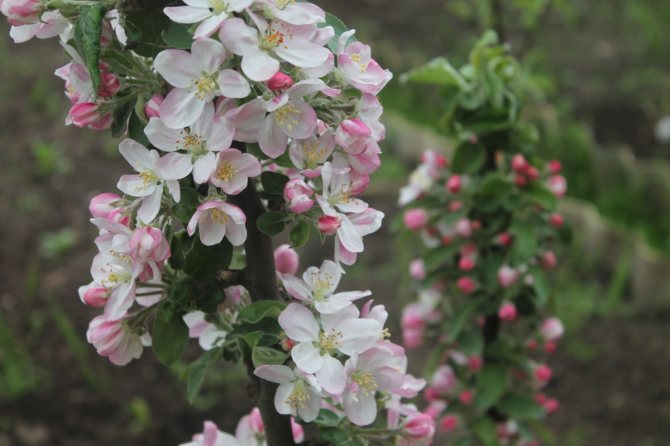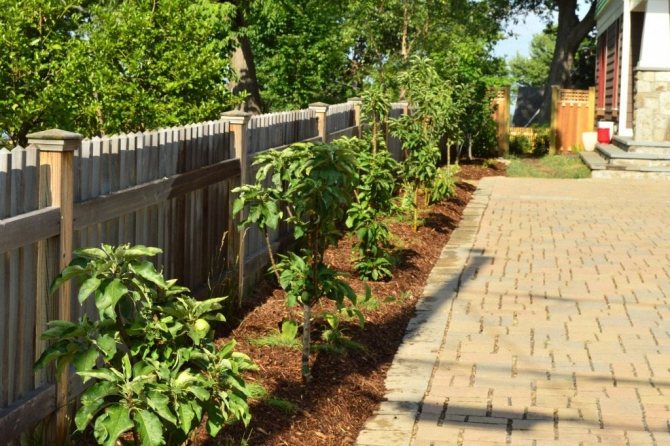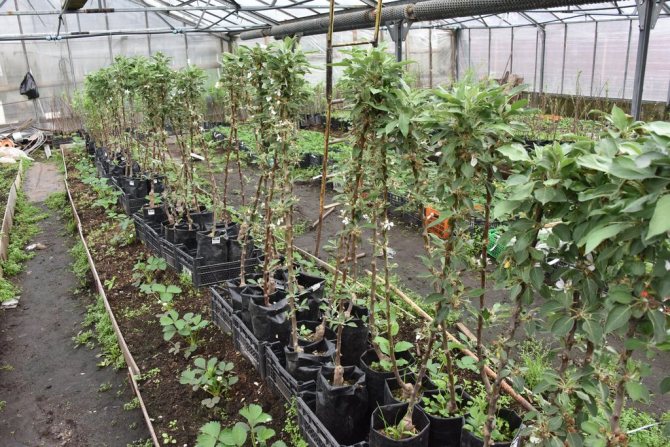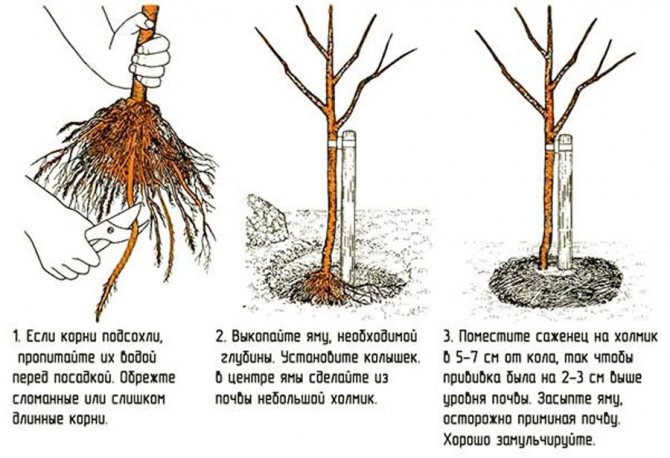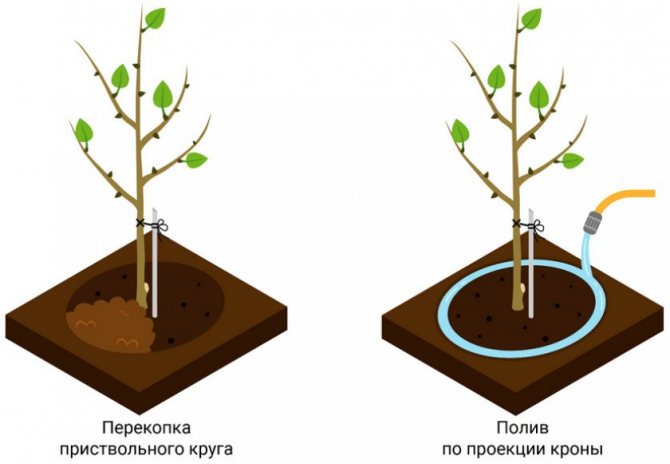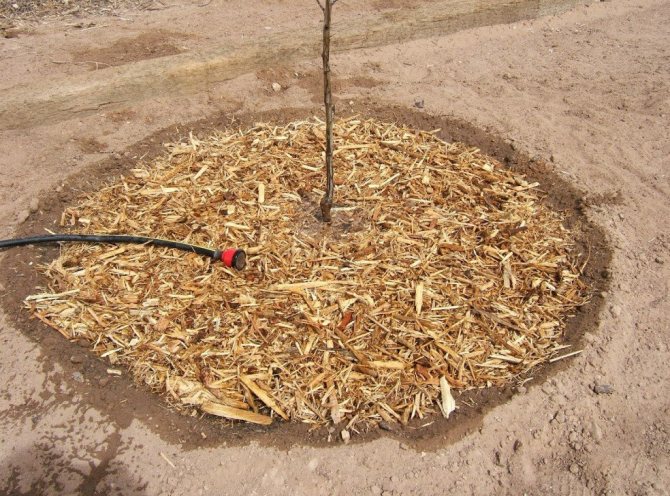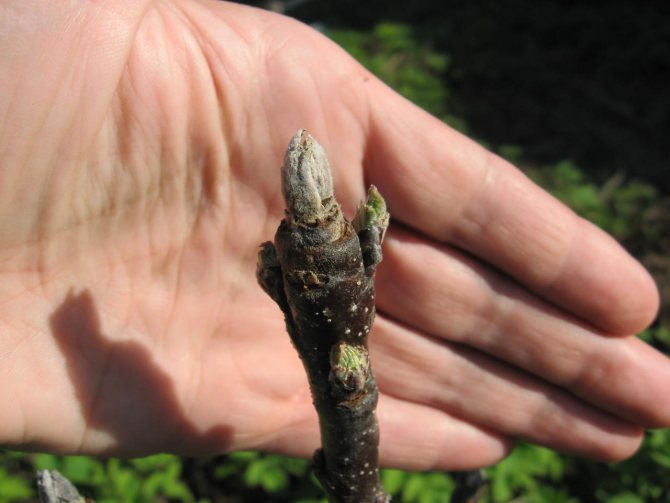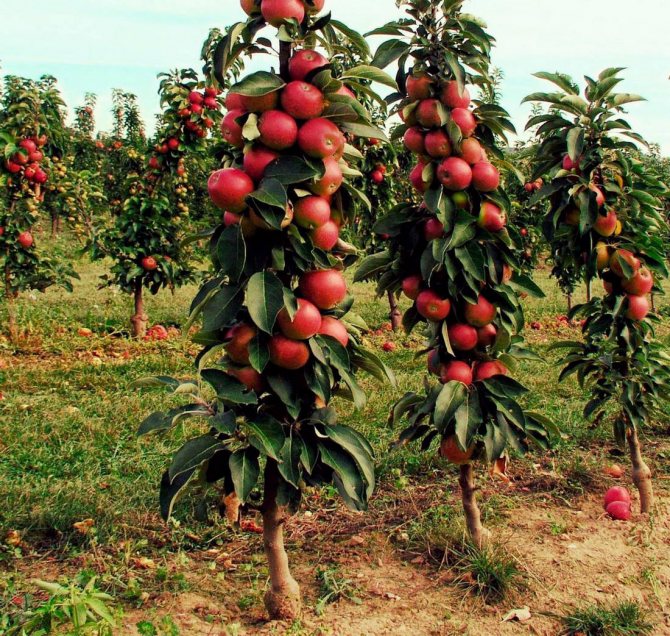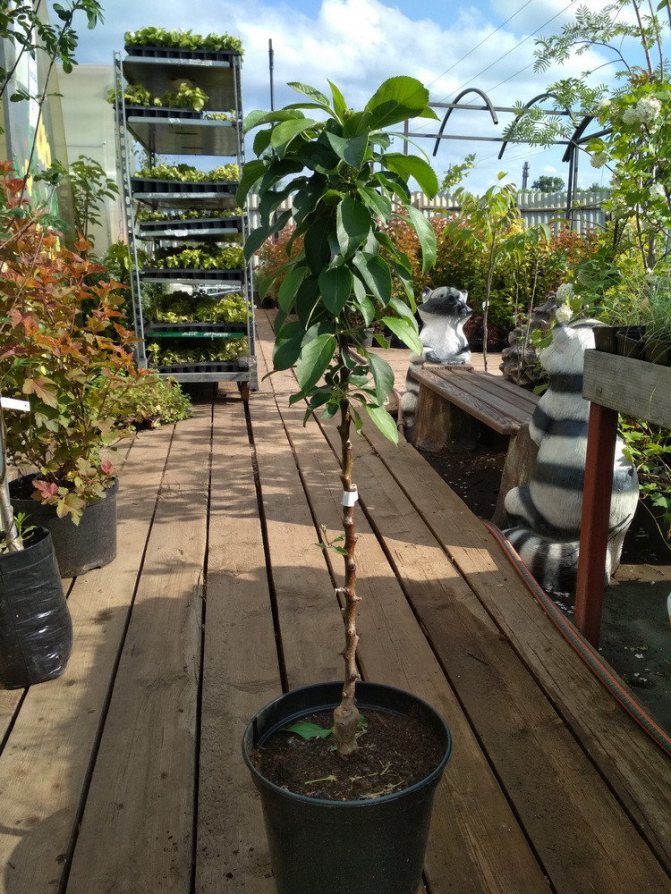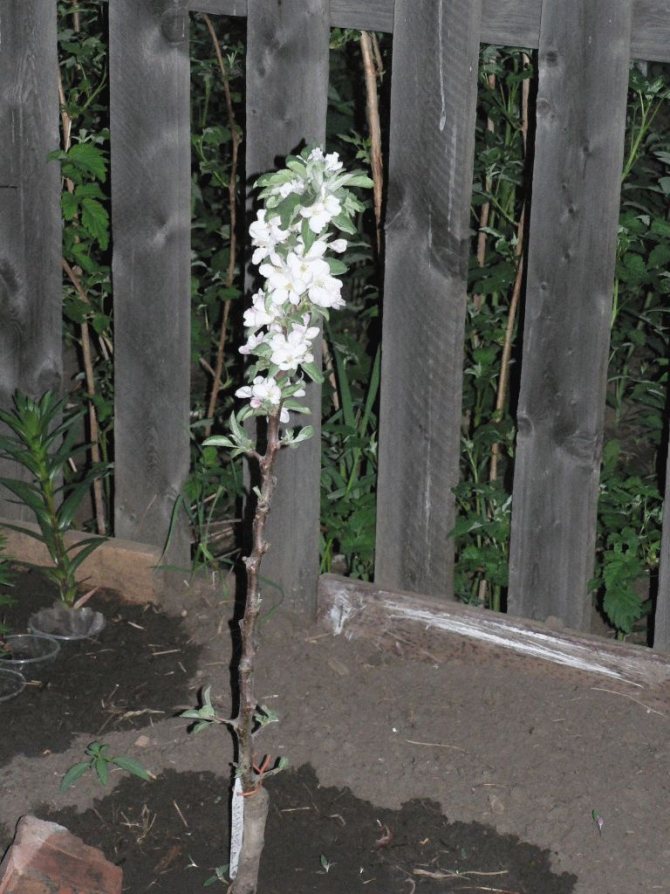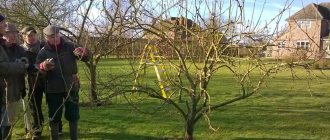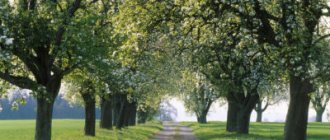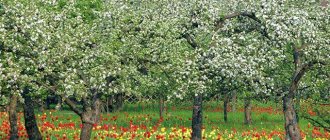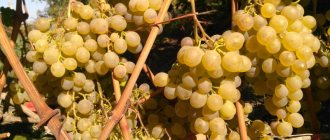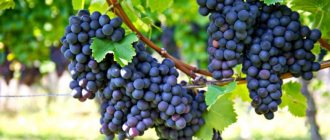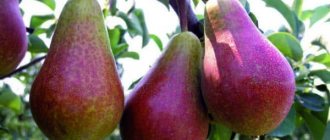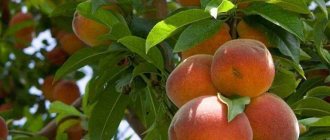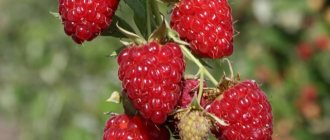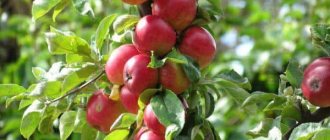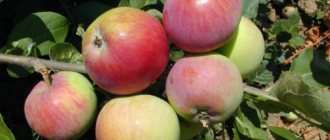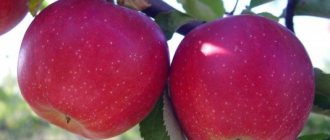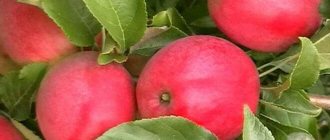Why are columnar varieties of apple trees good?
Vasyugan
The variety is late summer ripening, bred by domestic breeders in 1987. Possesses unique frost resistance, suitable for growing not only in the regions of central Russia, but also for Siberia and the Urals.
The tree is semi-dwarf, its height reaches no more than 3 meters. The crown has a strong foliage and compact size. Fruits are of medium or large size, the average weight is 100-140 g.
The apples are conical or elongated-conical. The skin is dense, yellow-green in color, with a pinkish blush. The pulp is creamy, fine-grained. The fruits have received high tasting ratings and are of the dessert type.
Vasyugan is a fast-growing and high-yielding apple variety. Fruiting can begin as early as the first year of planting. Every year the yield increases, for 4-5 years it reaches 6-7 kg / tree. The plant can bear fruit for up to 16 years.
It belongs to the autumn magpie variety of ripening. Bred and modified by domestic breeders, entered the official register in 1993.
The apple tree is represented by a semi-dwarf tree with powerful growth vigor. It has a columnar shape with a height of up to 2.2 m. The crown is compact, its width does not exceed 25 cm. It has a persistent root system that tolerates transplantation well. The variety is immune to disease.
Depending on the growing conditions, the weight of the fruit varies from 100 to 250 g. Apples are large in size. The skin is very dense, painted in a white-yellow tint, a slight blush is possible. The pulp is white, has a pleasant aroma, honey flavor and graininess.
Refers to varieties of universal use. The first fruiting is possible in the year of planting, but the maximum yield occurs only by the 5th year of growth. You can get up to 9 kg of apples from one tree. With proper care, the indicators increase significantly.
Currency
A winter variety bred by Moscow breeders through hybridization. Differs in complete immunity to scab, so it does not need annual preventive treatment for this disease. The variety entered the state register of the Russian Federation in 2004.
The apple tree is small in size. It reaches a height of only 2.3 m, the average crown width is 20 cm. Regardless of the rootstock, this is a semi-dwarf tree. The foliage has a rich green color, yellowing occurs very late in autumn.
The average weight of fruits is 100-140 g, when planted in favorable conditions, they can grow up to 250 g. Fruits are round in shape, the skin is thin with a slight glossy sheen. The apples are golden yellow with a red blush on the sides. Belongs to dessert type apple trees, the taste is close to sweet. The fruits are suitable for long-term storage.
The Currency variety has a late ripening period, the harvest can be harvested starting from the second decade of December. Productivity - 6-10 kg / tree, the maximum performance is reached at 5-6 years of growth. The life span of one plant is up to 50 years.
The president
It is considered one of the best domestic varieties of columnar apple for the Moscow region and not only. Widespread in central Russia. It entered the official register in 2002.
The height of the tree reaches more than 2 m, the crown has a dense and compact foliage.Fruit formations abundantly cover the trunk of the apple tree. It has a dense root system, due to which it tolerates transplantation well. The apples are large, depending on the age of the tree and the conditions of care, the weight varies from 140 to 250 g.
Fruits are symmetrical, flattened-rounded. Usually painted in a pale yellow color, there may be a purple-red blush on the sides. The skin is thin, with a shiny sheen. The pulp is fine-grained, juicy and tasty.
The President variety is distinguished by a high yield, during the first 5 years the figures reach up to 8 kg / tree. With proper care, when grown in regions without strong fluctuations in temperature, the yield can reach up to 16 kg / tree. The fruits ripen from late August to mid September. The minimum shelf life is 1.5 months.
Moscow necklace
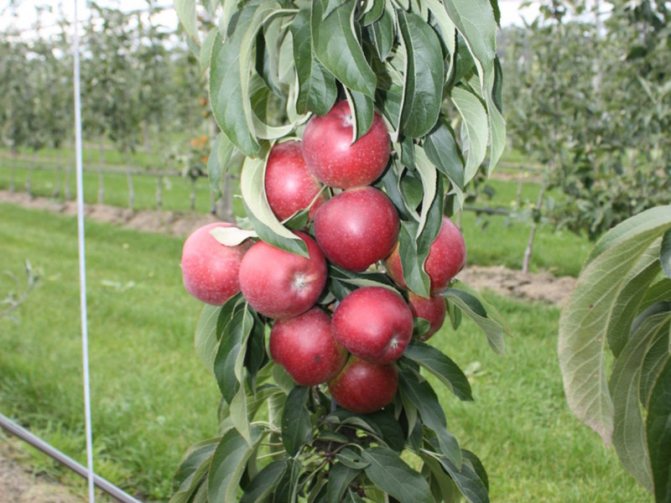
A variety of winter or autumn ripening period. Bred by domestic breeders under the leadership of M.V. Kachalkin. Especially popular in the middle lane and the Moscow region, where you can achieve maximum yield.
The apple tree is a natural semi-dwarf, reaching up to 2 m in height. The crown is compact, but densely leafy. The seedlings take root quickly, the root system is resistant to fungal diseases characteristic of the culture.
The spherical fruits are large, with an average weight of 130-250 g. The skin is thin, changes color as it ripens from green to deep red, there is a matt waxy bloom. The pulp is white, firm and juicy. The variety belongs to the dessert type, has a sweet taste and a slight sourness. The fruits retain their attractive presentation for a long time, are suitable for preservation, fresh consumption and drying.
Average yields are 6-10 kg / tree. After 15 years of cultivation in one place, the quality of fruiting decreases. The variety is frost-resistant, there is a tendency to overload with fruits.
The columnar apple tree is a natural clone of the culture. Its peculiarity is the presence of short fruit formations on the trunk and perennial vertical shoots (if any). At the same time, branching on such cultivars is weak or practically absent, especially in the first years of growth. All kinds of columnar apple trees have different vigor of growth (dwarfs - up to 1.5 m, semi-dwarfs - 2-2.2 m, vigorous - up to 3 m), live up to 10-15 years, respectively, give a harvest for 7-12 years.
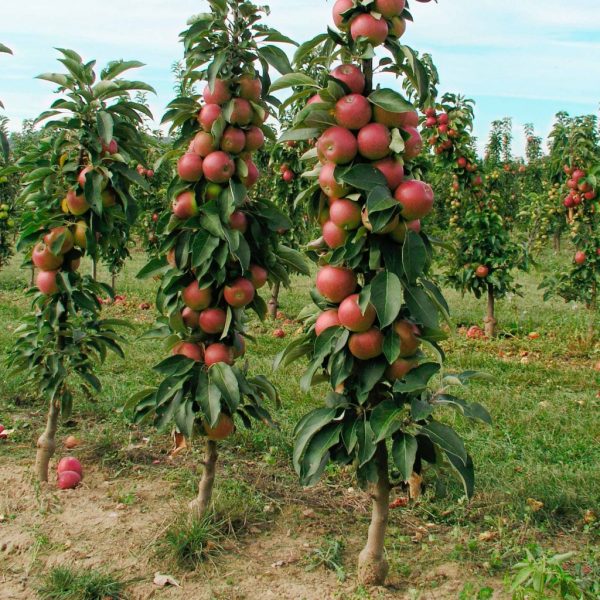

The peculiarity of columnar apple trees is not only small growth, but also in the specificity of fruiting - short fruit formations on the trunk
Columnar apple trees prefer sunny places without blowing winds and with the occurrence of groundwater no higher than 1.5 m. The layout of the site should be carried out according to the scheme: 40–60 cm between plants and 90–100 cm between rows.
With pronounced minimalism, many of the varieties suitable for growing in the Moscow region are large-fruited (apples weigh from 100 to 300 g). It is a pity that it will not be possible to collect an unprecedented harvest from such a dwarf - the average yield of a columnar apple tree is 8-15 kg (the yield of classic varieties with a normal crown is from 30 to 80 kg in different years).
Caring for columnar apple trees with a crown no higher than 2.5–3 m is easier than for tall ones:
- the crop can be harvested without a stepladder;
- it will be much faster to carry out preventive spraying of a small tree;
- it is easy to dig in the near-trunk circle - the central conductor of the columnar apple trees is smaller in diameter than that of the classic varieties.
Basically, these are quite frost-resistant varieties, despite the "looseness of wood", and self-fertile.
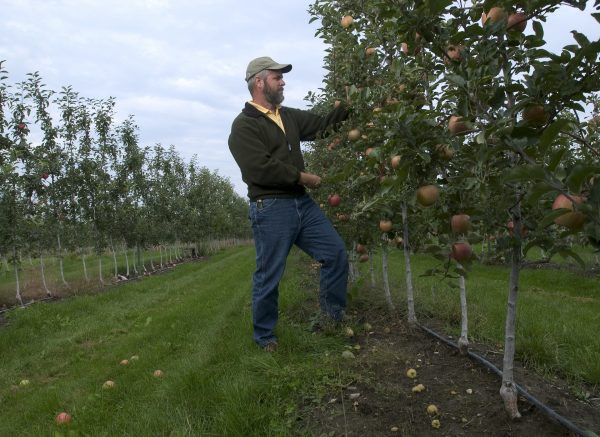

It is easy to harvest from apple-trees-columns, because they are not high
The clear advantage of the columns is that they do not take up much space. Such varieties are placed at a distance of 0.5-1 m from each other, and due to the small size of the crown, they do not oppress neighboring crops.
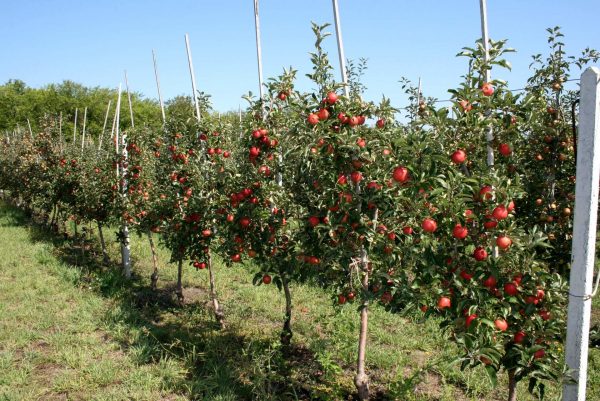

Apple-tree columns are planted at a distance of 50 cm to 1 m
Most of the varieties suitable for cultivation in the Moscow region are the result of the work of breeders of the All-Russian Institute of Selection and Technology of Horticulture and Nursery. The authorship of many cultivars belongs to Viktor Valerianovich Kichin, Honored Scientist of the Russian Federation.
The varieties differ in the ripening period, the period of entry into fruiting, and the yield. Each cultivar has characteristics of fruits - taste, color of the cover color, weight. Apples are stored in different ways and, accordingly, have different periods of consumption. The effectiveness of the cultivation of columnar apple trees also depends on the correctly selected planting site, compliance with the norms of culture, taking into account the climate.
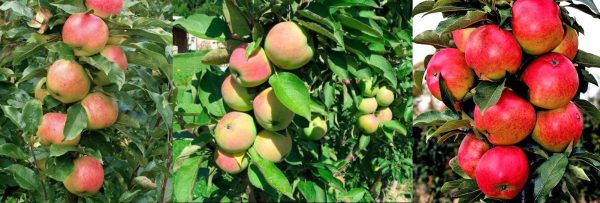

Columnar apple trees of different varieties differ in ripening period, period of entry into fruiting, yield
Experts recommend choosing modern columnar varieties proposed by the State Register of Breeding Achievements of the Russian Federation. They are a priority for farmers not only in the Moscow region and the Moscow region, but also in most regions of our country.
Summer varieties of apple-trees-columns begin to ripen at the end of June, fruits are removed from July to the end of August. Basically, the harvest of early apple trees is intended for fresh consumption, but they are not suitable for storage.
Columnar apple trees are planted in spring even before bud break. The landing pit (50x50x50 cm) must be drained. For different varieties of columnar apple trees, the prepared soil may differ, but it is better to choose a soil saturated with organic matter with high levels of moisture and air permeability (for example, chernozem). Humus or compost mixed with mineral fertilizers is added to the selected substrate, the proportions depend on the apple variety.
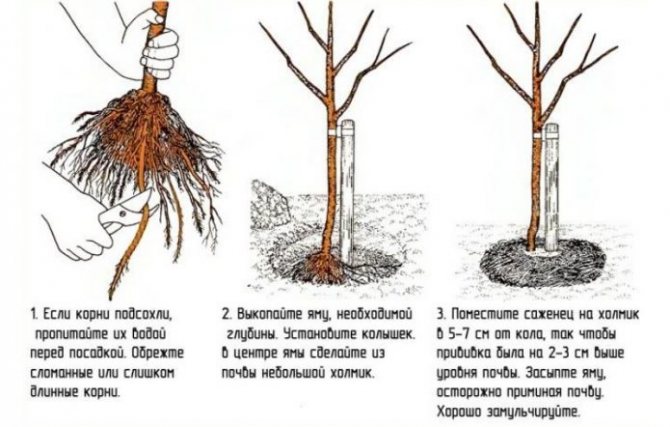

It is important not to damage the fragile root system of the apple tree seedling and place it correctly in the ground.
A columnar apple tree requires at least four additional fertilizing during the growing season of the plant. The composition and type of fertilizers, as well as the timing of fertilizing, may differ depending on the climate, region and selected variety.
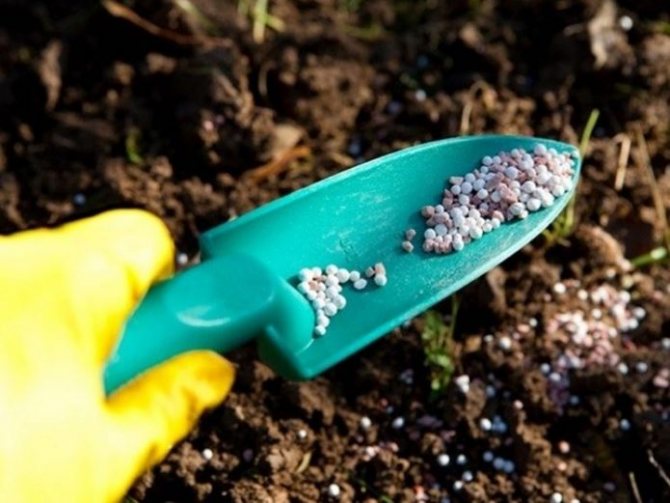

When fertilizing columnar apple trees, it is important to remember that these plants have a superficial root system and root burns can occur.
One apple tree needs 1-2 buckets of water for each watering. The frequency and method of watering depend on the weather conditions and on the soil substrate.
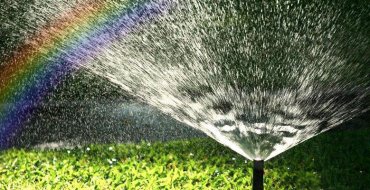

In dry and hot weather, sprinkling is useful for a garden of columnar apple trees, which is best done at sunrise or sunset.
Regulation of the load on columnar apple trees consists in timely intervention during the periods of ovary formation. Experienced gardeners remove almost all ovaries in the first year after planting, giving the plant time to prepare for a heavy load. You can leave 1-2 ovaries to see the characteristics of the fruit. The next year, half of the flowers are removed.
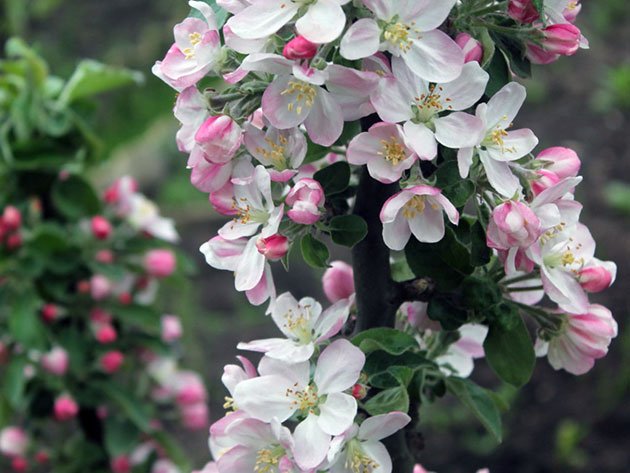

In the spring, correctly planted apple trees give a large number of flowers, but it is impossible that ovaries form from all of them: an excessive load on the trunk is harmful for a young plant
Columnar apple trees are famous for their shape. Healthy, well-chosen plants do not require pruning. But if the seedlings were genetically unhealthy, then the apple trees may have side shoots that need to be removed.
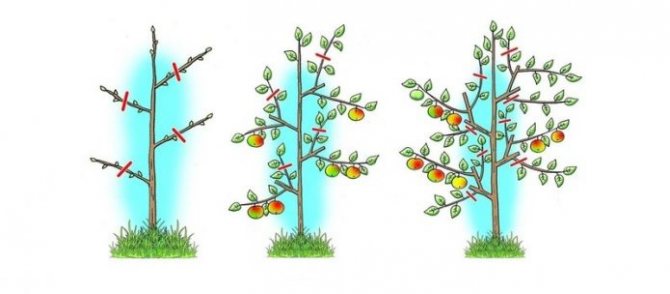

In columnar apple trees, only the lateral shoots are cut off, which do not bear fruit, leading the plants to the shape of a column
Pests and diseases
The President has resistance to many diseases. But it can be affected by scab, powdery mildew, fire blight. Also, the often columnar President apple tree suffers from attacks of pests, for example, aphids and ticks.
Scab
Despite its resistance to diseases, the plant is attacked by scab. As a preventive measure, before flowering, spray the plant with a solution of Bordeaux liquid, copper sulfate, and soapy water.If signs of scab appear, remove the infected fruit. Spray trees with fungicides such as Horus, Fitoflavin. Treat two weeks before or after harvest.
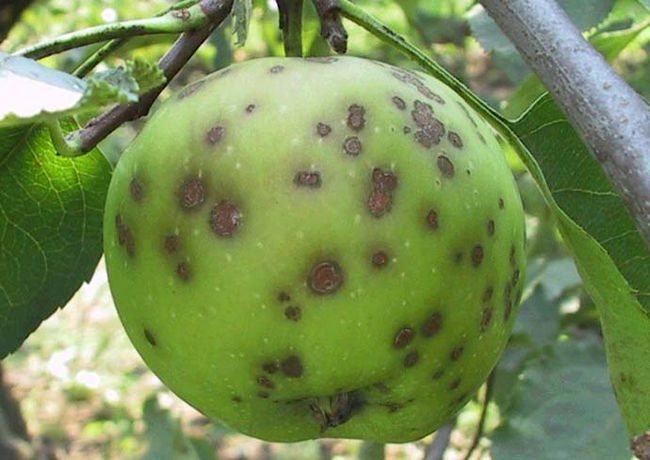

Powdery mildew
Spraying with copper sulfate, Bordeaux liquid, control of crown thickening, watering level helps from powdery mildew. Reduce watering if the weather is cool or damp. Fungicides are suitable for treating an already infected apple tree.
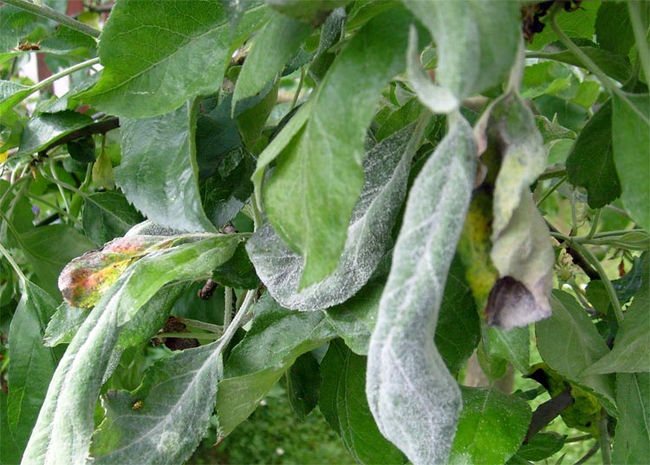

Bacterial burn
This is a dangerous disease that can no longer be cured in its advanced form. The most effective is prevention. To do this, in the spring and autumn, spray the plants with copper sulfate or Bordeaux liquid.
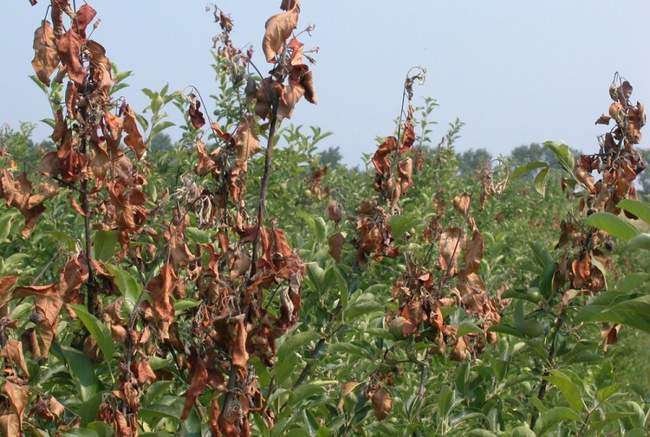

Pear affected by fire blight
It is also important to inspect the plant for cracks in spring and winter. If you find them, clean them, apply a bandage with an antiseptic, for example, Ofloxacin. It penetrates deeply into tissues, destroying harmful bacteria.
Two weeks before flowering, spray the plant with a solution of Ofloxacin or Ampicillin. And also with preparations of copper and zinc. Two tablets in a bucket of water.
If signs of a bacterial burn are found: blackening of shoots, milky bloom, distortion and deformation of fruits, spray the plant with Phytolavin. Remove all affected areas, strip the bark, apply antiseptic dressings.
Aphid
To deal with aphids, you will first have to solve the problem with ants. Otherwise, they will constantly drag them to the tree. To do this, you need to whitewash the trunk, you can install sticky traps so that insects cannot climb. Wrap duct tape around the barrel.
If pests are found, spray the plant with soapy water. If the affected area is small, then you can rinse the leaves and branches by hand. If the affected area is large, spray the plant with Insecticides. But processing can be carried out only after harvesting in autumn or spring, a couple of weeks before bud break.
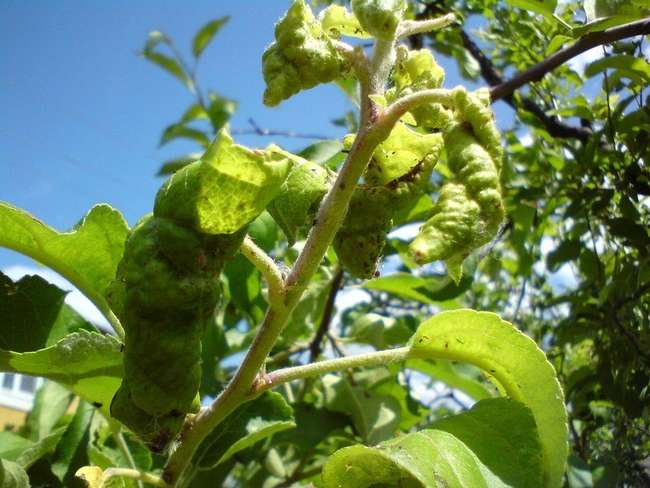

As a preventive measure, add ash to the trunk circle. It is a source of potassium, and insects do not tolerate too much of this element in plants. We recommend that you look at the article on controlling aphids in the garden, there you will find many methods for controlling the pest.
Mite
You can fight ticks using physical, chemical and biological methods. In the first case, it is prevention - collection and destruction of fallen leaves, fruits, filling cracks and removing damaged branches.
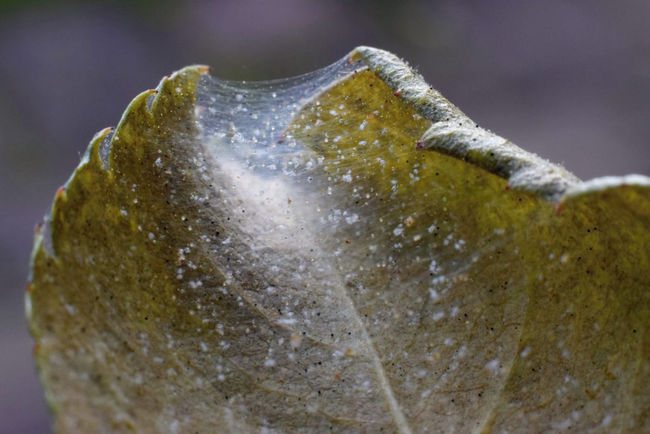

If the parasite does hit the plant, use insecticides - spray with Karbofos, Anti-Mite PRO, Karate Zeon. Carry out the processing before the beginning of bud formation in spring or in late summer and early autumn after harvest.
Safer drugs are Akarin, Vermitek, Fitoverm. They can be applied during flowering and harvesting.
Columnar apple varieties for the Moscow region
Moscow necklace
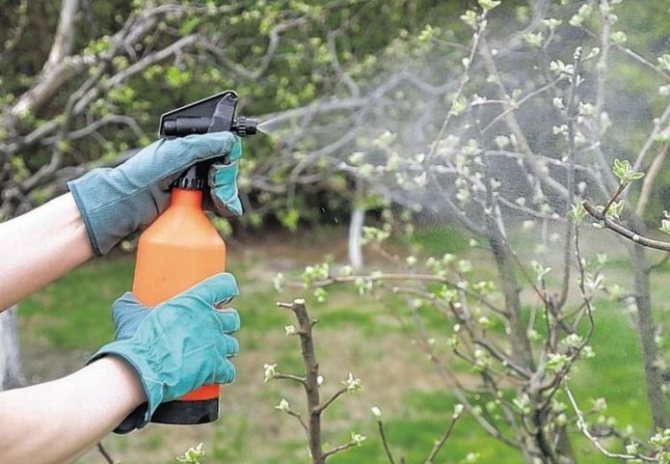

In spring, gardeners spray columnar apple trees to protect against aphids and other pests.
Columnar apple trees do not tolerate frost, so a lot depends on a good wintering. Plants require autumn whitewashing of the trunk and shelter for the winter. In addition, to protect against rodents, the lower part of the tree is covered with sawdust or spruce branches.
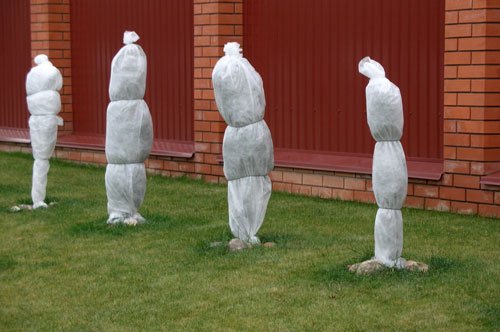

So that the growth point does not suffer, you need to cover the columnar apple trees, otherwise the growth of the tree will stop: spandbond and burlap are suitable for protection from the cold
Not all varieties of columnar apple trees are suitable for the Moscow region; it is necessary to choose only those that are resistant to prolonged negative temperatures. In addition to those listed below, gardeners of the Moscow region may also like Arbat, Vasyugan, Ostankino, President, Bolero, Moscow necklace, Jin, Titania.
- In fifth place is the Jin variety, which has a high winter hardiness, but only in the conditions of central Russia.The apple tree is capable of withstanding up to -25 ° C, but requires a mandatory shelter.
- The fourth place was shared by the varieties Dialogue and Amber Necklace, because both are able to withstand low temperatures down to -30 ° C. But the Dialog variety has a number of genetic marriages that can affect survival in extreme conditions. And the apple tree Amber Necklace for survival requires strict adherence to the rules of care and shelter for the winter.
- The three most seasoned leaders are opened by the Moscow necklace variety, which has winter hardiness at the level of Antonovka ordinary. The latter is able to withstand frosts down to -38 ° C. But the Moscow necklace can endure such cold weather only with abundant snow cover. If winter promises to be snowless, then it is better to cover the apple tree.
- The Iksha variety ranks second in the ranking of the most winter-hardy varieties of columnar apple trees, quite deservedly, because it is able to withstand frosts down to -40 ° C. Moreover, this variety is extremely resistant to extreme weather conditions.
- The honorable first place is occupied by a variety well known both to gardeners of the Moscow Region and to gardeners in Siberia. So, the most winter-hardy variety of columnar apple trees is Vasyugan. This unique apple tree can withstand temperatures as low as -42 º C.
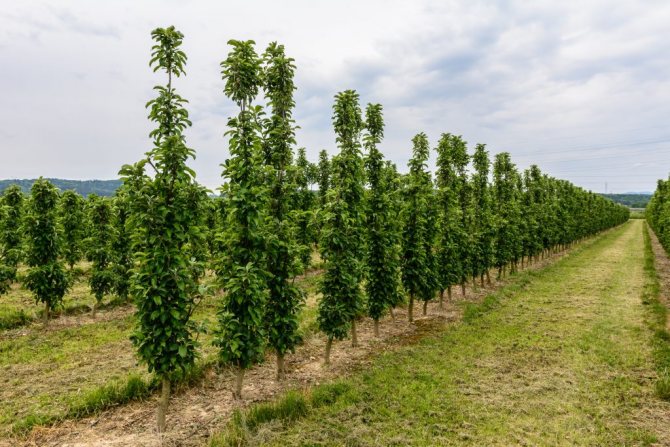

In areas where winters are not so harsh, but in summer the sun burns out all living things, columnar apple trees should be planted that can hold water, preventing it from quickly evaporating. The drought-resistant varieties include the Alluring aroma, Dialogue, President, Currency.
Planting columnar apple trees does not require special skills. They are planted like ordinary trees, only much closer to each other (at a distance of no more than 90 cm from each other), since they practically do not grow in width.
The holes are also not dug very deep. Trees need nutrients, so potash fertilizers (50-80 g) and superphosphate (50-100 g) must be added to the planting pit. After planting, the trees require abundant watering.
Columnar apple trees are mostly early-growing plants, but this can only be achieved with proper care. They need to be fed and watered regularly. Remember that already in the first year, apple trees produce a huge number of inflorescences, but experienced gardeners advise removing them to help the trees form a strong trunk. But in the second year, you can already enjoy a rich harvest.
There is one more nuance in the cultivation of columnar apple trees. It consists in the fact that their near-stem circles need to be tinned - this means sowing with herbs or cereals, which periodically need to be carefully cut or mowed. Such a procedure will help "ward off" insect pests from trees.
Watering columnar apple trees should be regular, preferably drip. If for some reason it is impossible to organize it, then it is recommended to water the trees 2-3 times a week. And 1-2 times a month for apple trees it is worth arranging a kind of "shower", watering not only the tree, but also the trunk.
It may seem that the columnar apple trees require special care. But, believe me, it's worth it, because a rich harvest will undoubtedly be your reward for your work.
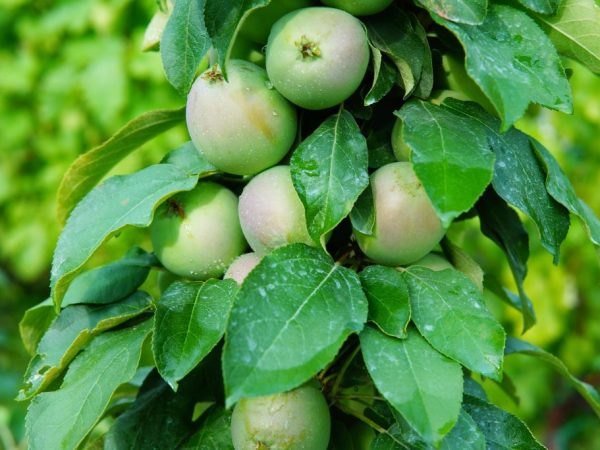

Good care will ensure you have a good harvest
The successful cultivation of columnar varieties depends on many factors: the site, the composition of the soil, the scheme and timing of planting, as well as further care and preparation for winter. Observing all the subtleties of growing, your work will be justified.
You can plant a columnar apple tree both in spring and in the autumn. But in this zone, gardeners prefer spring planting, because the risk of freezing of young apple trees and their subsequent death after wintering is reduced.
But if you have acquired planting material in the fall, it must be planted no later than the first ten days of October, so that young trees have time to take root and adapt in a new place before the onset of cold weather.
The optimal time for planting is early spring, when the snow melts. The main thing is to have time to plant the plants before the process of sap flow begins.
Preparation of seedlings
In order for the plants to take root quickly and successfully, it is recommended to use strong one-year or two-year-old seedlings without signs of diseases, pests and mechanical damage.
Before deepening into the soil, they are dipped for 2 hours in a clay solution (3 liters of clay per 3 liters of water).
Pit preparation
Before planting seedlings, you need to prepare a hole - its depth and width should correspond to the length and diameter of the roots (approximately 80x60 cm).
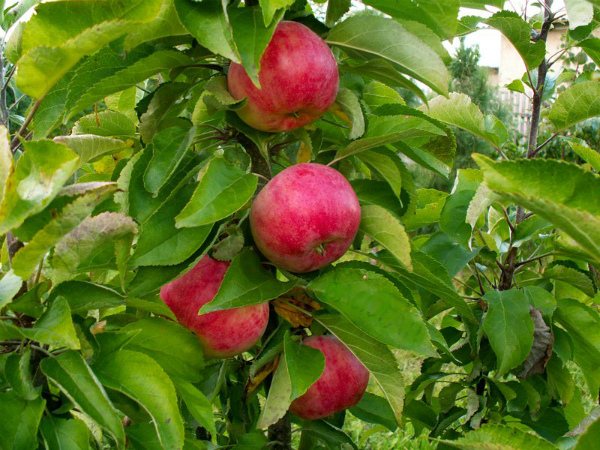

The dug earth is mixed with a bucket of last year's manure or compost, 100 g of potassium nitrate and 100 g of superphosphate are added.
Half a bucket of drainage is poured into the bottom of the pit - crushed stone, pebbles, pieces of broken bricks are suitable. Then the pit is half filled with a nutrient mixture, covered with a thin layer of soil without any additives to prevent the roots from burning.
A peg is driven in to tie the trunk and further protect from the winds.
The roots of the plant are lowered into a hole, leveled, sprinkled with soil and trampled around the stem. When planting, it is important that the area of the root collar is just above the ground.
Apple trees are watered with water (2 buckets for each plant) and the trunk area is sprinkled with an earthen hill to eliminate the risk of drying out the soil and roots.
For group planting, two schemes are used:
- compacted - the distance between trees is 0.5 m, in a row 1-1.5 m;
- sparse - the distance between seedlings and rows is 1 m.
What sort of columnar apple trees is better for the Moscow region ?!
Promising apple varieties for the Moscow region
What is the best apple variety for the Moscow region? Apple variety honey!
Care features
All subsequent care of young seedlings consists in regular watering and feeding.
- In the first 3 months, you should carefully monitor the condition of the soil around the seedlings - it should always be slightly moistened. Watering is carried out through grooves dug at a distance of 50 cm from the near-stem zone. 2-3 buckets of water are poured under one plant. Then they carry out the procedure of loosening the soil, removing weeds and mulching with garden soil. The frequency of watering depends on the condition of the soil and weather conditions - usually during the dry season, water at least 5 times.
- Columnar trees respond well to feeding with intensive growth, development and abundant yields. The first fertilizer is applied at the stage of blooming of vegetative buds. Use a composition of 1 st. l. azofoski or nitrophoska, 1 liter of mullein or bird droppings solution. The mixture is brought to a volume of 10 l with water. Pour 2 liters of nutrient liquid under each plant. After 15 days, the seedlings are re-fed with a solution of superphosphate and potassium salt - 1 tbsp. l. on a bucket of water.
- The main care consists in preventive treatments for infections and parasites. For diseases, fungicides are used - Bordeaux mixture or copper sulfate. Processing is carried out 3 weeks after planting the seedlings and in the fall closer to winter. From pests (aphids, moths, weevils and sawflies), the crown and soil around the near-trunk zone are sprayed with one of the insecticides - Aktellik, Konfidor, Calypso, Fufanon, Iskra or Sunmight.
- varieties do not need pruning or shaping, since they do not develop lateral branches. But in case of damage to the upper kidney on the central conductor, the growth of two or three apices is possible. Of these, you should choose the strongest one, and cut the rest.
- Normalization of flower buds and ovaries ensures full-fledged growth of a young plant and eliminates the risk of overloading a seedling that has not yet matured. In the first year of flowering, all buds are removed, which only take away strength and energy from a young tree. In the second year, only 5-6 fruit ovaries are left, and the rest are removed, in the third year - 15 apples. Starting from the fourth year of life, the apple tree is ready for full fruiting.
- In the first years of life, seedlings must be covered for winter, otherwise they will freeze and die. Before covering the apple tree, the trunk zone is mulched with a thick layer of earth (rotted manure or peat), then the trunk is wrapped with foil and covered with spruce branches or spunbond.
The temperate continental climate of central Russia, to which the Moscow region belongs, is distinguished by severe winters, hot summers, and prolonged rainy seasons. In different directions from the capital hail, the average annual seasonal temperatures can vary by several degrees.
The climate of the Moscow region in different directions has some differences:
- In the northwest, it is closer to Tverskoy.
- In the northeast towards Yaroslavsky.
- In the east to Vladimirsky.
- In the southeast towards Ryazan.
- In the south - Tula.
- In the southwest - Kaluga.
- In the west - Smolensky.
The capital is located in the center of the Moscow region, where climatic conditions can be considered average, but when planting and caring for fruit trees, you will have to focus on the climate of a particular area. The southeast of the region has the most severe winters and high summer temperatures.
The landscape of the region is flat, only in the western direction there are hills that rise to a maximum of 160 m.Accordingly, the soils in different parts of the Moscow region are also strikingly different from each other, which must be taken into account at the stage of preparing the site for planting apple trees, as well as the fact that the fertility of Moscow lands they do not differ.
How to grow such trees in a summer cottage
For self-cultivation of a culture, you need to know all its advantages and disadvantages.
The advantage of plants of this type, grown in Russian conditions, is:
- Almost all existing varieties of apple trees for the Moscow region are adapted for cultivation on soils common in the region. Their seedlings root well, quickly adapt to a new place.
- Another positive characteristic of these hybrids is the ability to tolerate the sharp drop in temperature that often occurs in early spring. The frost-resistant variety Moscow necklace tolerates the cold best of all, although another winter-hardy species, Bolero, is also suitable for the summer cottage.
- The advantage of columnar plants is the free access of a person to any fruit that has grown on a tree. This is because any such hybrid is undersized, which makes it possible to harvest without ladders.
- Care for seedlings is required for the first 2 months after planting. The farmer should carefully study the description of the care of the planted hybrid. The sprouts require constant moisture in the near-stem zone. Watering is carried out 3 times in 6-7 days.
- Young trees should be planted before the onset of winter. To do this, you will have to make a special trench so that it keeps the snow near the seedling.
Important! To get a specimen resistant to severe frosts, remove the topmost leaf on the seedling.
The growth of trees is carried out annually due to the appearance of side branches from the uppermost bud. Pruning of columnar hybrids is practically not carried out, although these procedures are sometimes necessary to reduce the density of foliage. To rejuvenate the branches, it is better to carry them out once every 2-3 years.
Pruning columnar apple trees
Apple trees for the Moscow region, the best varieties of which are desirable to grow on fertile loamy soils, are planted in early spring. For a seedling, a hole is dug about 100 cm deep and 0.8 m in diameter. Peat, manure (4-6 kg) or compost and sand are placed in it. Planting is carried out so that the root collar of the plant is at ground level. Around them make a root ditch with a shaft, pour water, make sure that this place does not dry out. When installing a tree in place, its roots must not be bent. Experts advise mulching the top soil layer. For this, peat, old leaves are suitable.To prevent the top of the seedling from freezing in winter, you need to exclude watering at the end of summer, and in the fall add nitrogen fertilizers to the soil.
For your information! Young growth begins in spring, feeding once a month with potash and phosphorus fertilizers. Slurry is also recommended, but in limited quantities, otherwise the apple tree will receive a severe burn.
Watering is carried out until the last days of summer. Each tree takes 40 liters of water. When the plants begin to bloom, you need to increase the intensity of irrigation, and during fruiting, reduce it by 1.5-2 times. In case of drought, on the contrary, increase by 2-3 times.
The apple orchard should consist of hybrids of different varieties. Although experts recommend breeding different types from each other. Even for columnar apple trees, the cultivation of close crops is used. This is necessary for the fertilization of trees, otherwise the harvest can not wait. In order for the plants to self-pollinate, you need to plant at least 3-4 types of columnar types. It is better to choose such a combination of seedlings, which consists of early types (yield in summer), mid-ripening types (fruits are harvested in autumn) and late ones, producing fruits in late autumn.
Blooming columnar apple trees
If the gardener does not have this opportunity, then he will have to attract insects. The best pollinator for the garden is the bee. First, the summer resident must find out if there is an apiary nearby. Then, in order to attract them to the site, a honey solution is applied to the leaves and trunks of the seedlings (1 teaspoon of honey per 1000 ml of water). This method allows all female flowers in the trees to be fully fertilized.
Currency
A winter variety of columnar apple trees that bear fruit well. The trees are dwarf, with a compact crown, do not require special care, and are resistant to most diseases. The apples are round, golden in color with a red blush, juicy, sweet and sour taste.
| Entering fruiting | Tree height (m) | Fruit weight (g) | Harvest | Shelf life |
| For 1-2 years | 1,5-1,8 | 100-120 | October | 3 months |
general description
Almost all varieties of this group are characterized by rapid growth, development and consistently high productivity.
Trees with a compact crown are fast-growing, with high adaptive abilities, therefore they grow well in areas of risky farming, have high resistance to various parasites and infections.
Unlike ordinary trees, the columnar apple tree does not tolerate wintering well. Life expectancy is no more than 15 years; even a rejuvenating haircut does not help the restoration of the apple tree.
After reviewing a brief description of zoned hybrids and varieties, you will be able to choose the most suitable crop for your garden.
Columnar apple trees - what could be easier
An important nuance is the high cost of planting material and the difficulty of choosing a high-quality rootstock. Those who have already faced the acquisition of apple-tree columns for their garden know this feature. Experienced gardeners and nursery owners believe that it is possible to grow a real columnar apple tree only by grafting onto a super-dwarf stock (R-22, M-9, PB-4 and others). But not every breeder approaches this issue responsibly - some are grafted onto medium-sized rootstocks, and the result is disastrous.
There is another problem: they say that seedlings (from different places) do not always bear fruit in the 3rd year, but on the 5th-6th they give small game. Experts say that this is a common phenomenon - the grafted "column" froze, and the harvest was obtained from wild stock.
In cases when apple trees with such a crown give 2-3 apples, experienced gardeners believe that the variety is wrongly chosen, even if the apple tree is zoned for the region where it grows.
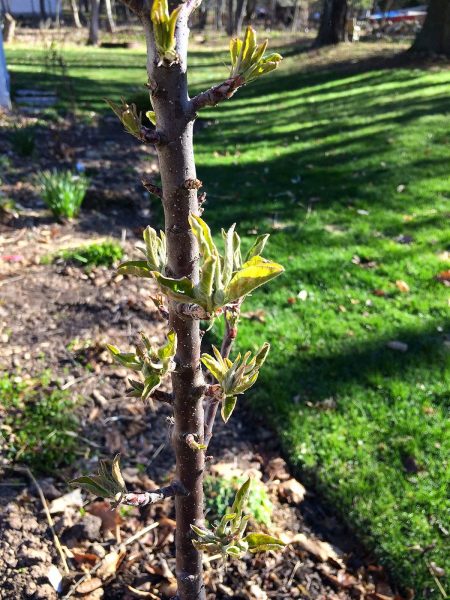

Choosing a high-quality columnar apple tree seedling is not an easy task.
It is important not only to choose a variety of columnar apple trees, but also to familiarize yourself with the planting rules, agricultural technology, and also find planting material from a responsible and experienced nursery owner (in no case from a reseller).
Feedback
Pyotr Ilyich
When I thought to start columnar apple trees in my suburbs, I read a lot of reviews. Among other information, a frighteningly often negative one was also encountered: they say the seedlings take root well and grow up to two meters, but they do not bloom and do not bear fruit. As a result, I made up my mind and went out of town to the nursery. There they showed me these apple trees "in action", so to speak, and convinced me that columnar varieties are not a myth. I bought three seedlings: Ostankino, Malyukha and Moscow Necklace. The very next year was with the harvest! Along with all the advantages, columnar trees also have a small disadvantage: such varieties live less than ordinary ones.
Iksha
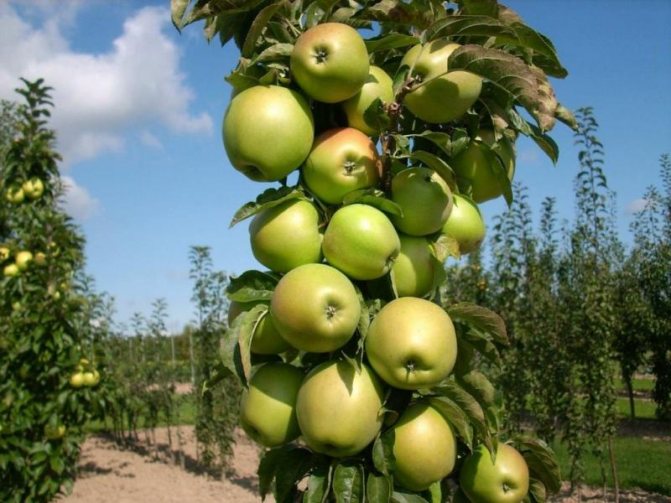

Autumn variety of high-yield columnar apple trees. The trees are short and compact. Fruits are round, yellowish with a striped blush. They taste sweet and sour, very juicy. Iksha apple trees are resistant to many diseases and pests.
| Entering fruiting | Tree height (m) | Fruit weight (g) | Harvest | Shelf life |
| For 1-2 years | 2 | 80-180 | End of August | 3 months |
Baby
An autumn variety of columnar apple trees that bear excellent fruit every year. The trees are not tall, they grow up to 1.8 m in height. Fruits are elongated, yellow-green in color with a slight pinkish blush, sweet and sour, with a pleasant aroma. The variety is highly resistant to diseases and pests.
| Entering fruiting | Tree height (m) | Fruit weight (g) | Harvest | Shelf life |
| For 1-2 years | 1,5-1,8 | 150-250 | September | 4 months |
Moscow necklace
Columnar apple trees of this late variety are distinguished by high yields. Up to 10 kg of fruit can be removed from one tree. Apple trees of medium height with a dense crown, fruits are round, dark red, juicy, very sweet. They can be eaten fresh or used for processing: drying, canning, etc.
| Entering fruiting | Tree height (m) | Fruit weight (g) | Harvest | Shelf life |
| For 1-2 years | 1,5-2 | 150-200 | September October | 6 months |
A winter variety of columnar apple trees that give a bountiful harvest. Trees take up little space, their crown is not spreading. The fruits are large, round, light yellow in color, very juicy and sweet in taste. The variety is considered one of the most resistant to most diseases.
| Entering fruiting | Tree height (m) | Fruit weight (g) | Harvest | Shelf life |
| For 1 year | 2-2,5 | 120-140 | Mid september | Seven months |
Harvesting and storage
Harvested in mid-August to mid-September. The President's apples have good keeping quality. They can be stored for up to two months. It is important to harvest whole, undamaged fruits, preferably from the tree itself, not fallen ones.
For longer storage, apples are placed in boxes in sawdust, paper, and put in a dark, cool place with medium humidity. The temperature should be no more than 5-10 degrees.
Check them constantly, at least once a week, remove damaged ones. So apples can be stored for up to six months.
The taste of apples allows them to be used for various types of preservation: jams, compotes, jam and others. Fruits are dried and wet, they make jams, marshmallows, even wine and juice from them. Fresh fruits, as well as those harvested with damage, can be used as a filling.
Ostankino
Autumn variety of columnar apple trees. The wood of these trees is very durable and hard, so the branches can easily withstand a large harvest. The fruits are greenish-yellow, almost completely covered with a violet-red blush. The apples are of the correct rounded shape.
| Entering fruiting | Tree height (m) | Fruit weight (g) | Harvest | Shelf life |
| 2 year | Up to 2 | 100-150 | End of August | 6 months |
Features of growing in the regions
A suitable growing region for the President's apple tree is Central. Winter is not too cold, and spring and summer are long enough for the plant to bear fruit. Also more northern regions are suitable for cultivation: the Saratov region. The plant feels great in the southern part of the country.
But it is not recommended to grow the variety in the Urals and Siberia. Winters are too harsh, and summers are short and not very warm, so the fruits do not have time to ripen. The upper part of the root system freezes out.

